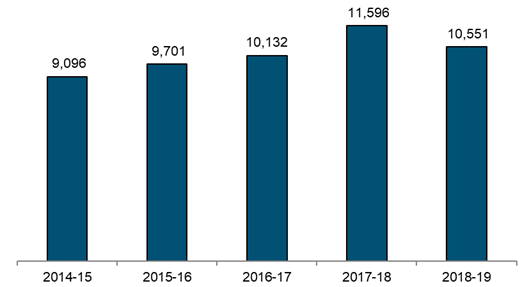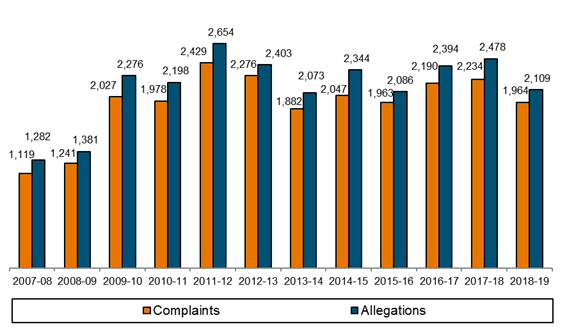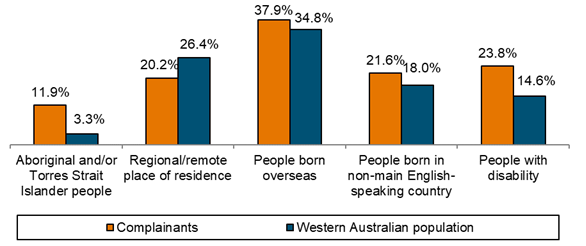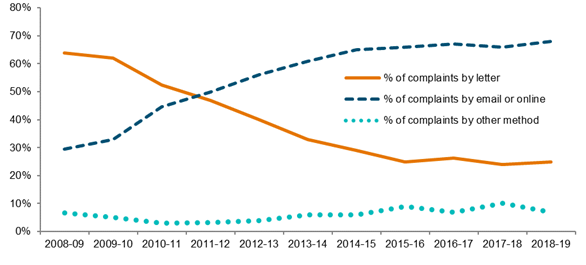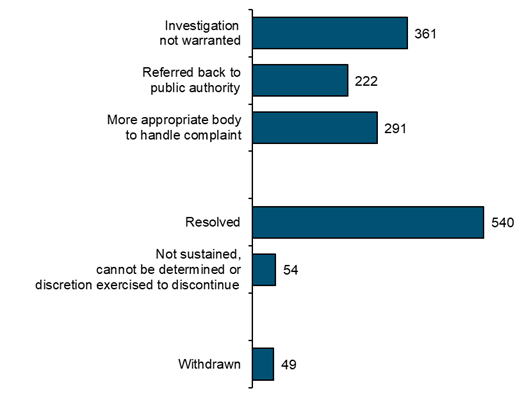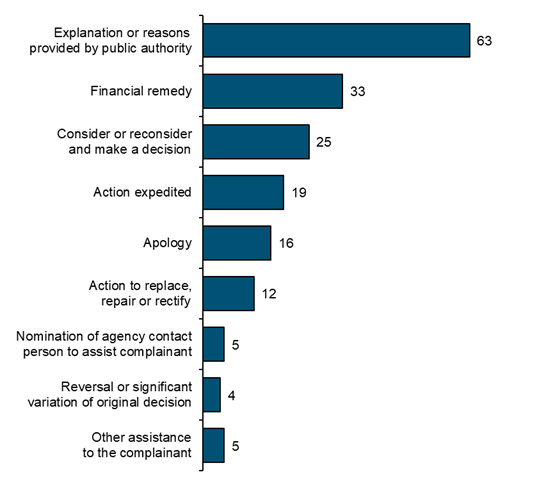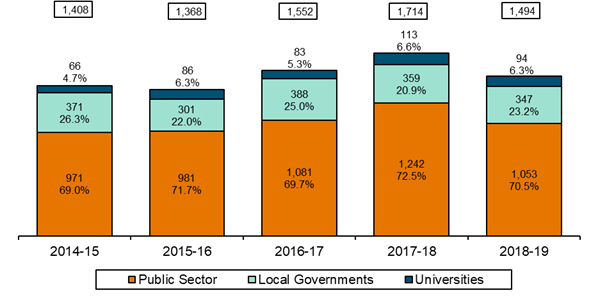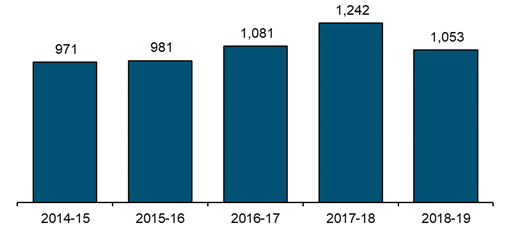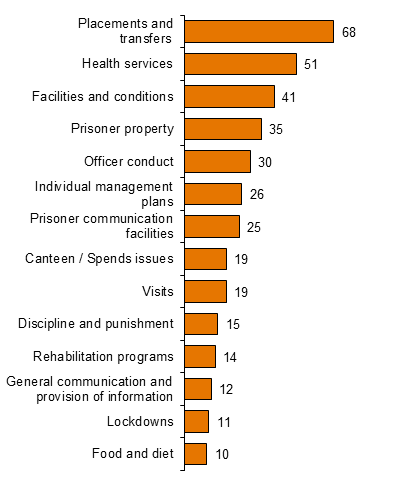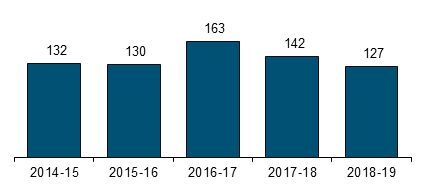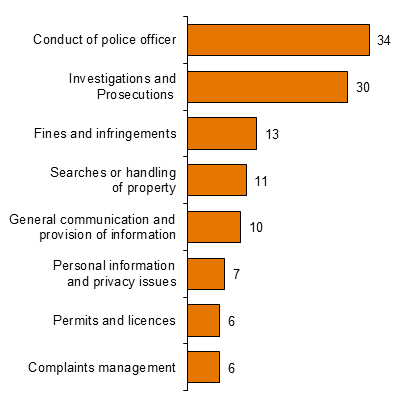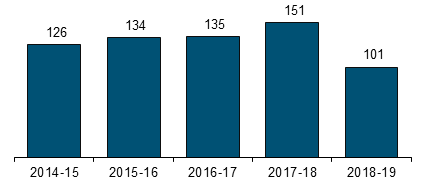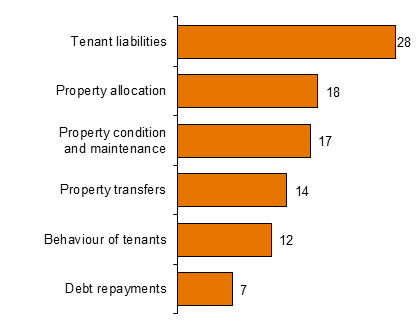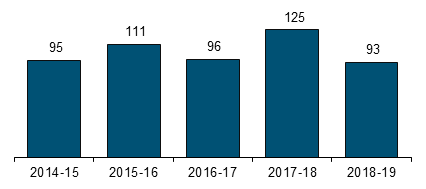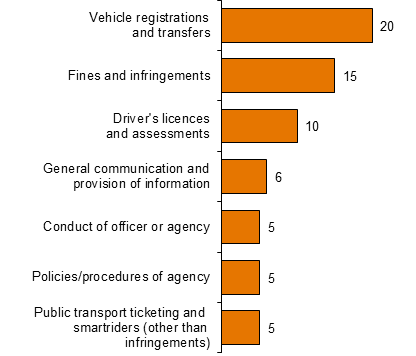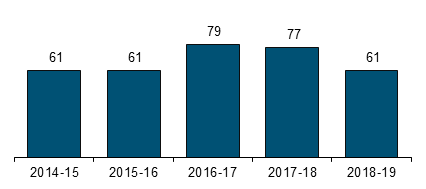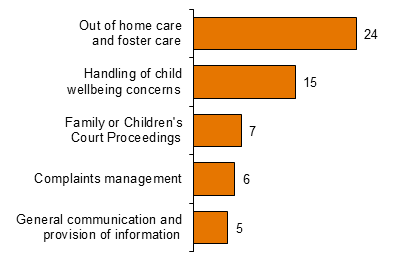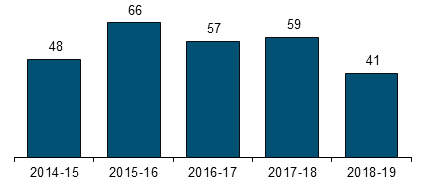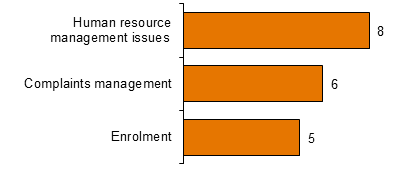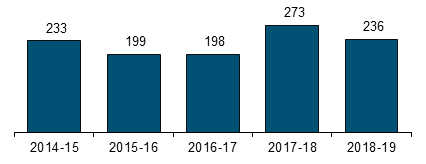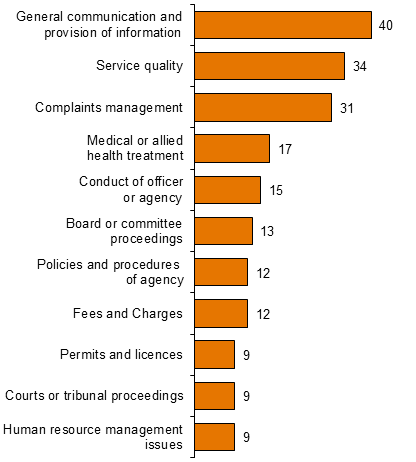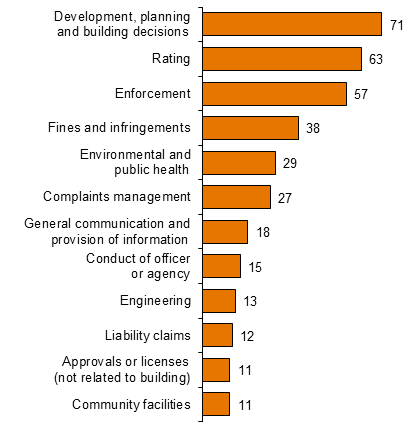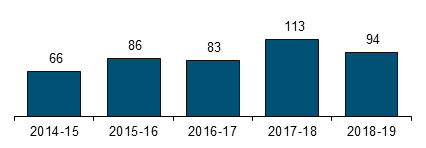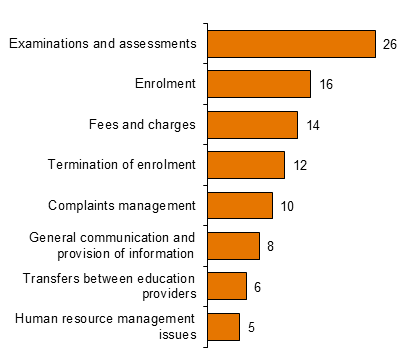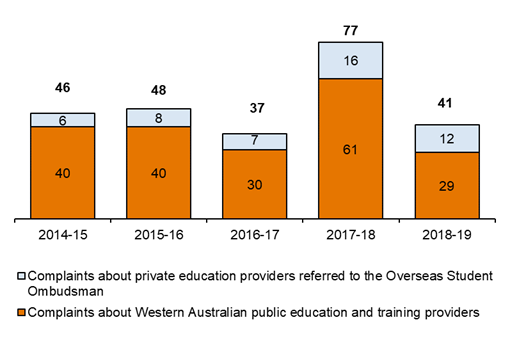Complaint Resolution
A core function of the Ombudsman is to resolve complaints received from the public about the decision making and practices of State Government agencies, local governments and universities (commonly referred to as public authorities). This section of the report provides information about how the Office assists the public by providing independent and timely complaint resolution and investigation services or, where appropriate, referring them to a more appropriate body to handle the issues they have raised.
Contacts
In 2018-19, the Office received 12,515 contacts from members of the public consisting of:
- 10,551 enquiries from people seeking advice about an issue or information on how to make a complaint; and
- 1,964 written complaints from people seeking assistance to resolve their concerns about the decision making and administrative practices of a range of public authorities.
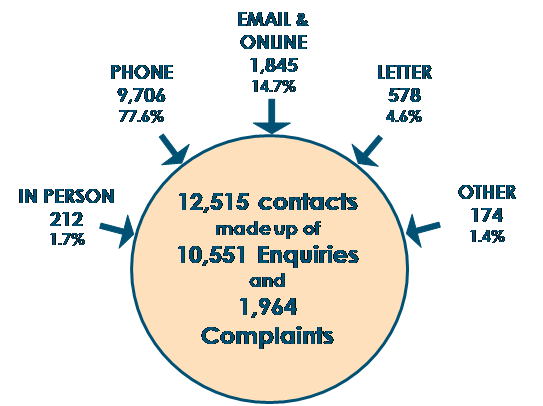
Enquiries Received
There were 10,551 enquiries received during the year.
For enquiries about matters that are within the Ombudsman’s jurisdiction, staff provide information about the role of the Office and how to make a complaint. For over 40% of these enquiries, the enquirer is referred back to the public authority in the first instance to give it the opportunity to hear about and deal with the issue. This is often the quickest and most effective way to deal with the issue. Enquirers are advised that if their issues are not resolved by the public authority, they can make a complaint to the Ombudsman.
For enquiries that are outside the jurisdiction of the Ombudsman, staff assist members of the public by providing information about the appropriate body to handle the issues they have raised.
Enquiries Received 2014-15 to 2018-19 |
|
Enquirers are encouraged to try to resolve their concerns directly with the public authority before making a complaint to the Ombudsman.
Complaints Received
In 2018-19, the Office received 1,964 complaints, with 2,109 separate allegations, and finalised 1,986 complaints. There are more allegations than complaints because one complaint may cover more than one issue.
| Total Number of Complaints and Allegations Received 2007-08 to 2018-19 |
|
NOTE: The number of complaints and allegations shown for a year may vary in this and other charts by a small amount from the number shown in previous annual reports. This occurs because, during the course of an investigation, it can become apparent that a complaint is about more than one public authority or there are additional allegations with a start date in a previous reporting year.
| Characteristics of Complainants in 2018-19 |
|
NOTE: Non-main English-speaking countries as defined by the Australian Bureau of Statistics are countries other than Australia, the United Kingdom, the Republic of Ireland, New Zealand, Canada, South Africa and the United States of America. Being from a non-main English-speaking country does not imply a lack of proficiency in English.
How complaints were made
Over the last 11 years, the use of email and online facilities to lodge complaints has increased and the proportion of people who lodge complaints by letter has declined.
In 2018-19, 68% of complaints were lodged by email or online, compared to 25% by letter and seven per cent by other methods including during regional visits and in person.
Methods for Making Complaints 2008-09 to 2018-19 |
|
Resolving Complaints
Where it is possible and appropriate, staff use an early resolution approach to investigate and resolve complaints. This approach is highly efficient and effective and results in timely resolution of complaints. |
Early resolution involves facilitating a timely response and resolution of a complaint. |
It gives public authorities the opportunity to provide a quick response to the issues raised and to undertake timely action to resolve the matter for the complainant and prevent similar complaints arising again. The outcomes of complaints may result in a remedy for the complainant or improvements to a public authority’s administrative practices, or a combination of both. Complaint resolution staff also track recurring trends and issues in complaints and this information is used to inform broader administrative improvement in public authorities and investigations initiated by the Ombudsman (known as own motion investigations). |
|
Time Taken to Resolve Complaints
Timely complaint handling is important, including the fact that early resolution of issues can result in more effective remedies and prompt action by public authorities to prevent similar problems occurring again. The Office’s continued focus on timely complaint resolution has resulted in ongoing improvements in the time taken to handle complaints.
Timeliness and efficiency of complaint handling has substantially improved over time due to a major complaint handling improvement program introduced in 2007-08. An initial focus of the program was the elimination of aged complaints.
Building on the program, the Office developed and commenced a new organisational structure and processes in 2011-12 to promote and support early resolution of complaints. There have been further enhancements to complaint handling processes in 2018-19, in particular in relation to the early resolution of complaints.
Together, these initiatives have enabled the Office to maintain substantial improvements in the timeliness of complaint handling.
In 2018-19:
|
95% of allegations were finalised within 3 months. |
Following the introduction of the Office’s complaint handling improvement program in 2007-08, very significant improvements have been achieved in timely complaint handling, including:
- The average age of complaints has decreased from 173 days to 48 days; and
- Complaints older than 6 months have decreased from 40 to 6.
Complaints Finalised in 2018-19
There were 1,986 complaints finalised during the year and, of these, 1,517 were about public authorities in the Ombudsman’s jurisdiction. Of the complaints about public authorities in jurisdiction, 874 were finalised at initial assessment, 594 were finalised after an Ombudsman investigation and 49 were withdrawn.
Complaints finalised at initial assessment
A quarter (25%) of the 874 complaints finalised at initial assessment were referred back to the public authority to provide it with an opportunity to resolve the matter before investigation by the Ombudsman. This is a common and timely approach and often results in resolution of the matter. The person making the complaint is asked to contact the Office again if their complaint remains unresolved. In a further 291 (33%) complaints finalised at the initial assessment, it was determined that there was a more appropriate body to handle the complaint. In these cases, complainants are provided with contact details of the relevant body to assist them.
Complaints finalised after investigation
Of the 594 complaints finalised after investigation, 88% were resolved through the Office’s early resolution approach. This involves Ombudsman staff contacting the public authority to progress a timely resolution of complaints that appear to be able to be resolved quickly and easily. Public authorities have shown a strong willingness to resolve complaints using this approach and frequently offer practical and timely remedies to resolve matters in dispute, together with information about administrative improvements to be put in place to avoid similar complaints in the future.
The following chart shows how complaints about public authorities in the Ombudsman’s jurisdiction were finalised.
Complaints Finalised in 2018-19 |
|
Note: Investigation not warranted includes complaints where the matter is not in the Ombudsman’s jurisdiction.
Outcomes to assist the complainant
Complainants look to the Ombudsman to achieve a remedy to their complaint. In 2018-19, there were 182 remedies provided by public authorities to assist the individual who made a complaint to the Ombudsman. In some cases, there is more than one action to resolve a complaint. For example, the public authority may apologise and reverse their original decision. In a further 56 instances, the Office referred the complaint to the public authority following its agreement to expedite examination of the issues and to deal directly with the person to resolve their complaint. In these cases, the Office follows up with the public authority to confirm the outcome and any further action the public authority has taken to assist the individual or to improve their administrative practices.
The following chart shows the types of remedies provided to complainants.
| Remedial Action to Assist the Complainant in 2018-19 |
|
 |
| Young people get access to the internet |
| A group of young people living in accommodation provided by a public authority contacted the Ombudsman to complain that they did not have adequate access to the internet. They said this meant they were missing out on education, as they needed the internet for their homework, and could not communicate with their friends. Following an investigation by the Ombudsman, the public authority acknowledged the provision of internet was an access issue across all accommodation provided by the public authority. The public authority confirmed that it would progress the installation of internet access to all relevant accommodation across Western Australia. |
Outcomes to improve public administration
In addition to providing individual remedies, complaint resolution can also result in improved public administration. This occurs when the public authority takes action to improve its decision making and practices in order to address systemic issues and prevent similar complaints in the future. Administrative improvements include changes to policy and procedures, changes to business systems or practices and staff development and training.
About the Complaints
Of the 1,964 complaints received, 1,494 were about public authorities that are within the Ombudsman’s jurisdiction. The remaining 470 complaints were about bodies outside the Ombudsman’s jurisdiction. In these cases, Ombudsman staff provided assistance to enable the people making the complaint to take the complaint to a more appropriate body.
Public authorities in the Ombudsman’s jurisdiction fall into three sectors: the public sector (1,053 complaints) which includes State Government departments, statutory authorities and boards; the local government sector (347 complaints); and the university sector (94 complaints).
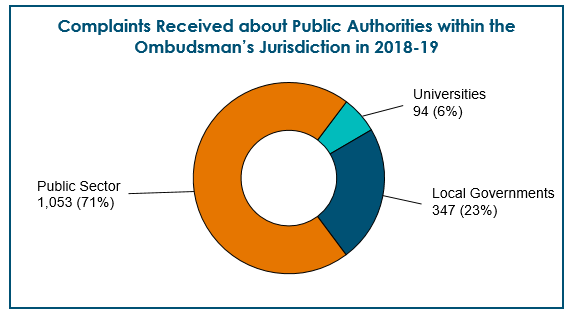
The proportion of complaints about each sector in the last five years is shown in the following chart.
| Complaints Received about Public Authorities within the Ombudsman’s Jurisdiction between 2014-15 and 2018-19 |
|
The Public Sector
In 2018-19, there were 1,053 complaints received about the public sector and 1,070 complaints were finalised. The number of complaints about the public sector as a whole since 2014-15 is shown in the chart below.
| Complaints Received about the Public Sector between 2014-15 and 2018-19 |
|
Public sector agencies deliver a very diverse range of services to the Western Australian community. In 2018-19, complaints were received about key services as shown in the following chart.
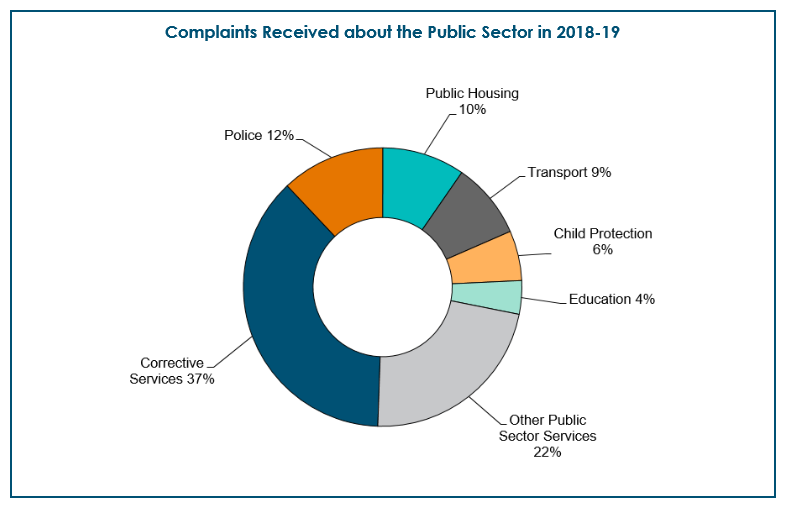
Of the 1,053 complaints received about the public sector in 2018-19, 78% were about six key service areas covering:
- Corrective services, in particular prisons (394 or 37%);
- Police (127 or 12%);
- Public housing (101 or 10%);
- Transport (93 or 9%);
- Child protection (61 or 6%); and
- Education, including public schools and TAFE colleges (41 or 4%). Information about universities is shown separately under the university sector.
For further details about the number of complaints received and finalised about individual public sector agencies and authorities, see Appendix 1.
Outcomes of complaints about the public sector
In 2018-19, there were 161 actions taken by public sector bodies as a result of Ombudsman action following a complaint. These resulted in 129 remedies being provided to complainants and 32 improvements to public sector practices.
The following case studies illustrate the outcomes arising from complaints about the public sector. Further information about the issues raised in complaints and the outcomes of complaints is shown in the following tables for each of the six key areas and for the other public sector services as a group.
 |
| Charges to tenant waived and staff training provided |
| A tenant was charged by a public authority for repairs and maintenance after the tenant had vacated the property and a third party entered the property and caused damage. The tenant complained to the Ombudsman that their individual circumstances meant they were not liable for the charges. Following enquiries by the Ombudsman, the public authority reviewed the charges and acknowledged that the correct procedures had not been followed. As a result, the public authority agreed to waive the charges and conduct training to avoid a similar occurrence in the future. |
 |
| Prison phone charges reviewed |
| A prisoner complained they were being charged incorrectly for outgoing telephone calls to a local number in the metropolitan area. Following enquiries by the Ombudsman, the public authority reviewed the charges and determined the call rate was incorrect. The public authority apologised to the prisoner and reimbursed the overcharged amount. The public authority also agreed to review the charges from the site to ensure no one else was similarly overcharged and change the telephone software programming to reflect the correct call rate. |
Corrective Services |
||
Complaints received |
|
|
Most common allegations |
|
|
Outcomes achieved |
|
|
Police |
||
Complaints received |
|
|
Most common allegations |
|
|
Outcomes achieved |
|
|
Public Housing |
||
Complaints received |
|
|
Most common allegations |
|
|
Outcomes achieved |
|
|
Transport |
||
Complaints received |
|
|
Most common allegations |
|
|
Outcomes achieved |
|
|
Child Protection |
||
Complaints received |
|
|
Most common allegations |
|
|
Outcomes achieved |
|
|
Education |
||
Complaints received |
|
|
Most common allegations |
These figures include appeals by overseas students under the National Code of Practice for Providers of Education and Training to Overseas Students 2018 relating to TAFE colleges and other public education agencies. Further details on these appeals are included later in this section. |
|
Outcomes achieved |
|
|
Other Public Sector services |
||
Complaints received |
|
|
Most common allegations |
|
|
Outcomes achieved |
|
|
The following case study provides an example of action taken by a public sector agency as a result of the involvement of the Ombudsman.
 |
| Application for transfer approved |
| A tenant applied to a public authority for a priority transfer from their rental property on medical grounds, which was declined. The tenant complained to the Ombudsman. Following enquiries by the Ombudsman, the public authority gave further consideration to the tenant’s particular circumstances and the medical evidence provided. Having reviewed the matter, the public authority made a discretionary decision to approve the transfer. |
The local government sector
The following section provides further details about the issues and outcomes of complaints for the local government sector.
Local Government |
||
Complaints received |
|
|
Most common allegations |
|
|
Outcomes achieved |
|
|
 |
| Local government assists resident |
| A person complained to the Ombudsman that a local government was not taking reasonable action to address vegetation on the verge adjacent to their property which was causing damage to their fence. Following enquiries by the Ombudsman, the local government conducted a site inspection and noted that the offending vegetation did not originate from its verge. However, to assist the resident, the local government agreed to remove the vegetation, spray the area as a deterrent and conduct regular inspections to monitor possible regrowth. |
The university sector
The following section provides further details about the issues and outcomes of complaints for the university sector.
Universities |
||
Complaints received |
|
|
Most common allegations |
|
|
Outcomes achieved |
|
|
 |
| Student given opportunity to apply for readmission |
| A student applied for readmission to their university after being excluded. The university declined the request for readmission and decided that the student’s
re-enrolment would be denied for two further academic years. The student complained to the Ombudsman. As a result of the Ombudsman’s investigation, the university reviewed its decision and agreed to reverse its decision preventing the student from applying for readmission in future academic years. The university also agreed to amend its procedures to ensure that where the university proposes to deny re-enrolment, the student is provided with sufficient notice to allow them a reasonable opportunity to consider and respond to all material being considered by the decision maker |
Other Complaint Related Functions
Reviewing appeals by overseas students
The National Code of Practice for Providers of Education and Training to Overseas Students 2018 (the National Code) sets out standards required of registered providers who deliver education and training to overseas students studying in Australian universities, TAFE colleges and other public education agencies. It provides overseas students with rights of appeal to external, independent bodies if the student is not satisfied with the result or conduct of the internal complaint handling and appeals process.
Overseas students studying with both public and private education providers have access to an Ombudsman who:
- Provides a free complaint resolution service;
- Is independent and impartial and does not represent either the overseas students or education and training providers; and
- Can make recommendations arising out of investigations.
In Western Australia, the Ombudsman is the external appeals body for overseas students studying in Western Australian public education and training organisations. The Overseas Students Ombudsman is the external appeals body for overseas students studying in private education and training organisations.
Complaints lodged with the Office under the National Code
Education and training providers are required to comply with 11 standards under the National Code. In dealing with these complaints, the Ombudsman considers whether the decisions or actions of the agency complained about comply with the requirements of the National Code and if they are fair and reasonable in the circumstances.
| Complaints Received from Overseas Students under the National Code between 2014-15 and 2018-19 |
|
During 2018-19, the Office received 41 complaints from overseas students, including 29 complaints about public education and training providers. All 29 complaints about public education and training providers were about universities, and none were about TAFE colleges or other education providers. The Office also received 12 complaints that, after initial assessment, were found to be about a private education provider. The Office referred these complainants to the Overseas Students Ombudsman.
The 29 complaints by overseas students about public education and training providers involved 34 separate allegations. There are more allegations than complaints because one complaint may cover more than one issue. The most common issues raised by overseas students were decisions about:
- Examinations and assessments (10);
- Termination of enrolment (7);
- Enrolment (6);
- Fees and charges (5);
- Transfers between education and training providers (4); and
- Management of academic misconduct (1).
During the year, the Office finalised 46 complaints about 54 issues.
 |
| University reconsiders its decision not to release student |
| An international student requested to be released from their university course to enable study with a different provider located in another state, on compassionate grounds due to family circumstances. The university decided that the student did not meet the criteria for release, based on the evidence provided. The student appealed the university’s decision but was unsuccessful, and they complained to the Ombudsman. As a result of the Ombudsman’s investigation, the university reviewed the new information and documentation provided by the student and reversed its decision to deny the request for release. The university also agreed to adopt a new format to record its decisions about applications for release and to provide students with information about the evidence required to support applications for release. |
 |
| University refunds tuition fees |
| A university student was expelled from a university for engaging in academic misconduct. By the time the internal review process for the expulsion decision was finalised, the student had provisionally enrolled in a further semester of study and paid the relevant tuition fees. After the university’s expulsion decision, the student applied for a refund of the tuition fees for units in which they were provisionally enrolled, but the university refused. The student complained to the Ombudsman. As a result of the Ombudsman’s investigation, the university reconsidered the application of its tuition refund policy and agreed to refund the tuition fees. |
Public Interest Disclosures
Section 5(3) of the Public Interest Disclosure Act 2003 allows any person to make a disclosure to the Ombudsman about particular types of ‘public interest information’. The information provided must relate to matters that can be investigated by the Ombudsman, such as the administrative actions and practices of public authorities, or relate to the conduct of public officers.
Key members of staff have been authorised to deal with disclosures made to the Ombudsman and have received appropriate training. They assess the information provided to determine whether the matter requires investigation, having regard to the Public Interest Disclosure Act 2003, the Parliamentary Commissioner Act 1971 and relevant guidelines. If a decision is made to investigate, subject to certain additional requirements regarding confidentiality, the process for investigation of a disclosure is the same as that applied to the investigation of complaints received under the Parliamentary Commissioner Act 1971.
During the year, two disclosures were received.
Indian Ocean Territories
Under a service delivery arrangement between the Ombudsman and the Australian Government, the Ombudsman handles complaints about State Government departments and authorities delivering services in the Indian Ocean Territories and about local governments in the Indian Ocean Territories. There were no complaints received during the year.
Terrorism
The Ombudsman can receive complaints from a person detained under the Terrorism (Preventative Detention) Act 2006, about administrative matters connected with his or her detention. There were no complaints received during the year.
Requests for Review
Occasionally, the Ombudsman is asked to review or re-open a complaint that was investigated by the Office. The Ombudsman is committed to providing complainants with a service that reflects best practice administration and, therefore, offers complainants who are dissatisfied with a decision made by the Office an opportunity to request a review of that decision.
In 2018-19, six reviews were undertaken, representing less than one third of one per cent of the total number of complaints finalised by the Office. In all cases where a review was undertaken, the original decision was upheld.
Go to next section of the Annual Report 2018-19 >>
Go to previous section of the Annual Report 2018-19>>
Go back to Annual Reports page >>
To read a pdf, you will need Adobe Acrobat Reader, which can be downloaded
for free from Adobe at http://www.adobe.com/products/
acrobat/readstep2.html.

